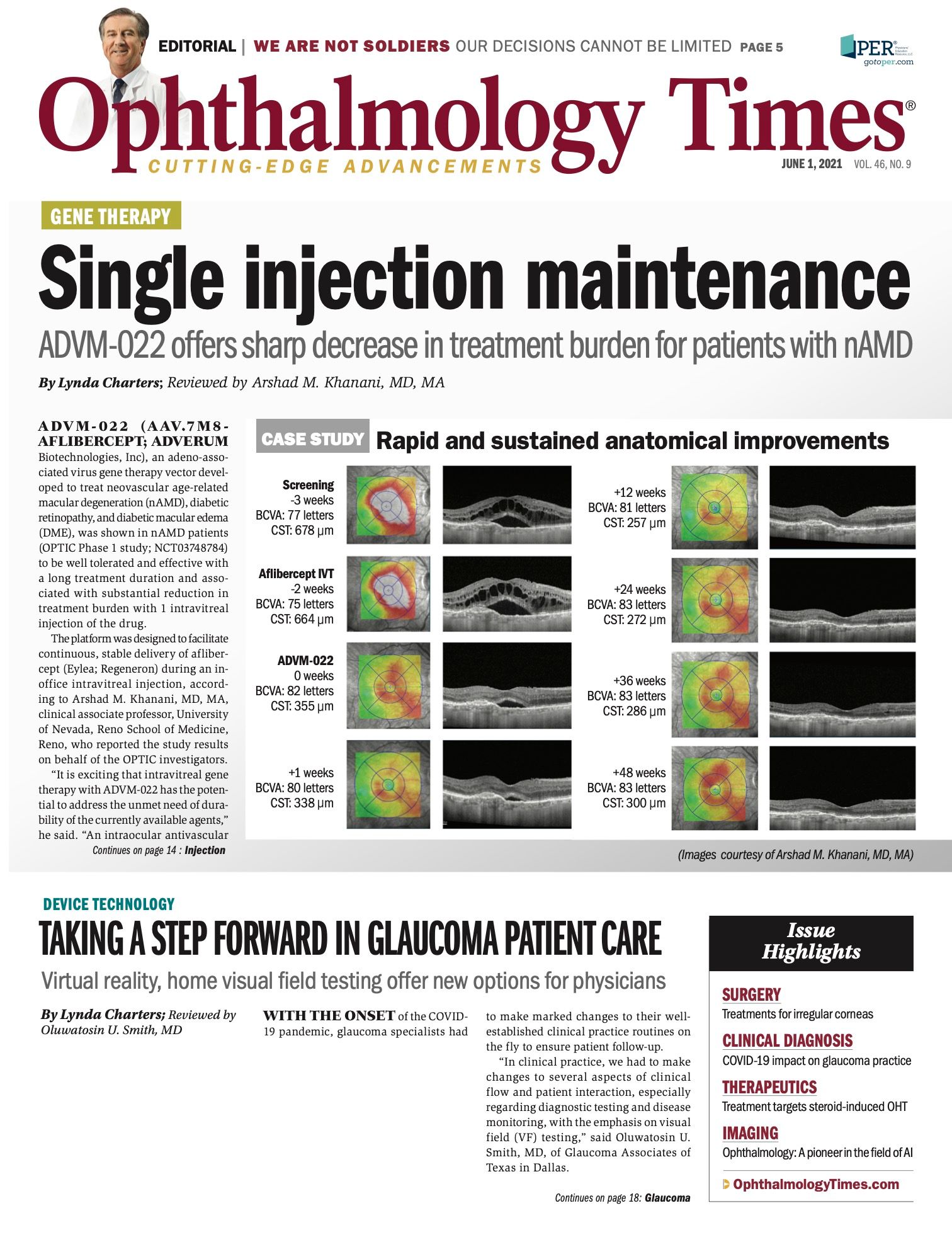Publication
Article
Digital Edition
Research: Treatment targets steroid-induced OHT
Author(s):
Measurements from multiple studies show benefits of rho-kinase inhibition.


Reviewed by W. Daniel Stamer, PhD
Findings from a series of preclinical and retrospective clinical studies suggest the rho-kinase inhibitor (ROCKi) netarsudil (Rhopressa; Aerie Pharmaceuticals) may be the preferred treatment for steroid-induced ocular hypertension (OHT).
As reported in a recently published article [Li G, et al. Elife. 2021Mar 30;10:e60831], the research showed that netarsudil effectively prevented and reduced steroid-induced OHT in an animal model.
In addition, analyses of in vivo spectral domain optical coherence tomography (SD-OCT) images and from histologic examination of tissue from sacrificed animals revealed that the ROCKi attenuated steroid-induced pathologic changes in the conventional outflow pathway.
Related: Rho kinase inhibitors: Filling a gap in glaucoma treatment
The benefits observed in the animal model were corroborated by the results of retrospective clinical studies showing reductions of IOP were achieved upon initiation of netarsudil among 2 independent cohorts of patients with steroid-induced OHT that was refractory to standard glaucoma medications.
W. Daniel Stamer, PhD, is a professor of ophthalmology at Duke University in Durham, North Carolina, where he directs a research laboratory focusing on the pathobiology of OHT in glaucoma.
“It is well known that steroids interfere with aqueous outflow through the conventional pathway by increasing extracellular matrix deposition, cell contractility, and tissue stiffness,” he said. “Now our group has shown for the first time that it is possible to reverse those changes using a medication that directly targets cells in the conventional outflow pathway.”
Pratap Challa, MD, a glaucoma specialist and associate professor of ophthalmology, Duke University, said the studies show that netarsudil has strong potential to treat steroid-induced glaucoma, particularly because steroids increase outflow resistance at the level of the trabecular meshwork and netarsudil acts directly on this tissue.
Related: Taking a step forward in glaucoma patient care
“Ideally, a benefit of netarsudil for treating or preventing steroid-induced OHT should be established based on randomized prospective clinical trials,” Challa said. “It seems reasonable based on the available evidence, however, that clinicians might strongly consider using netarsudil for IOP lowering in patients who are steroid responders.”
Laboratory research
Stamer and colleagues conducted their preclinical studies using a mouse model of steroid-induced OHT in which an implant containing dexamethasone-loaded nanoparticles is injected subconjunctivally.
“We demonstrated previously that this treatment predictably results in IOP elevation and in the same characteristic morphological changes that are seen in human eyes with steroid-induced OHT,” Stamer said.
The activity of netarsudil for countering steroid-induced IOP elevations was shown in 2 experiments.
In one study, netarsudil or placebo was administered as a preventive intervention beginning 1 day prior to steroid delivery and continued for 4 weeks to cover the duration of steroid exposure from implant release.
Related: Unplugging the clogged drain in glaucoma
The second study investigated netarsudil as a therapeutic modality to reverse steroid-induced changes. In this second experiment, netarsudil or placebo were started 3 weeks after steroid delivery.
Tissue effects of netarsudil treatment were investigated in the latter group of animals and demonstrated reversal of the outflow dysfunction and associated extracellular matrix deposition and fibrotic changes.
These studies included a novel approach for estimating trabecular meshwork stiffness that applied inverse finite element modeling to SD-OCT images.
The findings were confirmed through direct measurements obtained using atomic force microscopy.
“It was especially noteworthy that the trabecular meshwork regained normal biomechanical properties and exhibited significant improvement in extracellular matrix morphology within 4 days after the animals were started on netarsudil treatment,” Stamer said.
Related: Drainage device offers IOP lowering capabilities at 1 year
Clinical benefits
The activity of netarsudil as treatment for steroid-induced OHT was investigated by identifying cohorts of patients who were refractory to conventional IOP-lowering medications.
The first series of patients was identified through a retrospective search of the electronic medical record system at the Duke Eye Center.
It included 21 eyes of 19 patients whose steroid-induced OHT failed to respond to aqueous humor suppressors (carbonic anhydrase inhibitors and/or adrenergics) and in some cases, prostaglandin analogue treatment as well.
Mean IOP at baseline (prior to starting netarsudil) was 24.3 mm Hg. At 1 month after starting netarsudil and without any tapering of the steroid dose, mean IOP decreased to 16.4 mm Hg.
The second cohort of patients was derived from a retrospective chart review of patients seen by glaucoma specialist John R. Samples, MD, with NVISION Eye Center in Portland, Oregon.
Related: A menu of glaucoma treatments includes options to fit all scenarios
It included 11 eyes of 8 patients. Mean IOP in this group was 26.5 mm Hg prior to starting netarsudil, and it was reduced to 19.5 mm Hg with the use of netarsudil.
Promising diagnostic technology
Going forward, Stamer and colleagues are collaborating with Felipe Medeiros, MD, PhD, professor of ophthalmology at Duke University, and Ross Ethier, PhD, professor of biomedical engineering at Georgia Tech, to develop the SD-OCT imaging-based approach as a clinical tool for functional evaluation of the conventional outflow system in patients with POAG.
“With steroid-induced OHT, we know that it might be possible to intervene with medication before the steroid-induced fibrotic changes become permanent, but the status of the conventional outflow pathway is more of an unknown in the larger population of patients with POAG,” Stamer concluded. “A method for assessing the function of the conventional outflow system might help clinicians individualize treatment decisions with regard to a role for ROCKi treatment and it could also be used for monitoring treatment.”
---
W. Daniel Stamer, PhD
e:dan.stamer@duke.edu
Stamer has received research support from Aerie Pharmaceuticals, Aerpio, Allergan, Bausch + Lomb, Broadwing Bio, Editas Medicine, and Regeneron, serves on scientific advisory boards for Aerpio, Broadwing Bio, Glauconix, and Qlaris, and has stock options in Glauconix and Qlaris.
Pratap Challa, MD
e:Pratap.challa@duke.edu
Challa owns equity in Aerie Pharmaceuticals.

Newsletter
Don’t miss out—get Ophthalmology Times updates on the latest clinical advancements and expert interviews, straight to your inbox.




